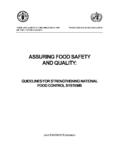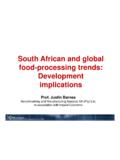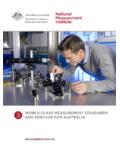Transcription of Food Quality and Safety Systems - A Training …
1 food Quality and Safety Systems - A Training Manual on food Hygiene and the Hazard Analysis and Critical Control Point (HACCP) System Table of Contents food Quality and Standards Service food and Nutrition Division food AND agriculture ORGANIZATION OF THE UNITED NATIONS. Rome, 1998. Editing, design, graphics and desktop publishing: Publishing Management Group, FAO Information Division Reprinted with corrections 1998. The designations employed and the presentation of material in this publication do not imply the expression of any opinion whatsoever on the part of the food and agriculture Organization of the United Nations concerning the legal status of any country, territory, city or area or of its authorities, or concerning the delimitation of its frontiers or boundaries.
2 M-83. ISBN 92-5-104115-6. All rights reserved. No part of this publication may be reproduced, stored in a retrieval system, or transmitted in any form or by any means, electronic, mechanical, photocopying or otherwise, without the prior permission of the copyright owner. Applications for such permission, with a statement of the purpose and extent of the reproduction, should be addressed to the Director, Information Division, food and agriculture Organization of the United Nations, Viale delle Terme di Caracalla, 00100 Rome, Italy.
3 FAO 1998. This electronic document has been scanned using optical character recognition (OCR). software and careful manual recorrection. Even if the Quality of digitalisation is high, the FAO. declines all responsibility for any discrepancies that may exist between the present document and its original printed version. 1. Table of Contents Foreword Preface Section 1 - PRINCIPLES AND METHODS OF Training . Introduction Module 1 - Principles of effective communication - "Getting the message across". Module 2 - Effective oral communication Module 3 - Why train?
4 The trainer's role and responsibility Module 4 - Methods of Training - The right method Module 5 - The art of questioning Module 6 - Types of Training aids - How to make and use them Module 7 - Planning and delivering a presentation Module 8 - Evaluating Training Module 9 - Testing trainee trainers - Individual presentations Module 10 - Organizing and managing a Training course Section 2 - RECOMMENDED INTERNATIONAL CODE OF PRACTICE - GENERAL. PRINCIPLES OF food HYGIENE. Introduction Module 1 - The Codex Alimentarius Commission Module 2 - The Codex General Principles of food Hygiene Module 3 - Primary production Module 4 - Establishment: design and facilities Module 5 - Control of operation Module 6 - Establishment: maintenance and sanitation Module 7 - Establishment: personal hygiene Module 8 - Transportation Module 9 - Product information and consumer awareness Module 10 - Training Section 3 - THE HAZARD ANALYSIS AND CRITICAL CONTROL POINT (HACCP).
5 SYSTEM. Introduction Module 1 - History and background of the HACCP system Module 2 - The Codex guidelines for the application of the HACCP system Module 3 - Assemble the HACCP team - Task 1. Module 4 - Describe product and identify intended use - Tasks 2 and 3. Module 5 - Construct flow diagram and on-site confirmation of flow diagram - Tasks 4 and 5. Module 6 - List all potential hazards associated with each step, conduct a hazard analysis and consider any measures to control identified hazards - Task 6/Principle 1.
6 Module 7 - Determine critical control points - Task 7/Principle 2. Module 8 - Establish critical limits for each critical control point - Task 8/Principle 3. Module 9 - Establish a monitoring system for each critical control point - Task 9/Principle 4. Module 10 - Establish corrective actions - Task 10/Principle 5. Module 11 - Establish verification procedures - Task 11/Principle 6. Module 12 - Establish documentation and record keeping - Task 12/Principle 7. 2. Annex 1 - Blank HACCP forms Annex 2 - The application of risk analysis to food Safety control programmes Foreword The food and agriculture Organization of the United Nations (FAO) is the principal specialized UN agency dealing with all aspects of food Quality and Safety throughout each of the stages of food production, storage, transportation, processing and marketing.
7 Work in this area is carried out by the food Quality and Standards Service of the FAO food and Nutrition Division. Activities include providing policy advice and executing food Quality control and Safety development projects, including the development of food standards and technical regulations; food Quality and Safety assurance programmes for the food industry; establishing national export food certification programmes; monitoring programmes for food contaminants;. and conducting regional and national seminars and workshops on food control issues.
8 One important element of FAO's work is building the capacity of food control personnel, including government authorities and food industry personnel carrying out food Quality and Safety assurance programmes. Such programmes should include specific food risk control procedures such as the Hazard Analysis and Critical Control Point (HACCP) system. In December 1994, FAO held an expert consultation on HACCP principles in food control. The experts recommended that FAO should continue to emphasize high- Quality and effective food industry and government HACCP Training , based on the development of a core curriculum and the harmonized text and guidelines of the Codex Alimentarius Commission.
9 In February 1995, an ad hoc working group was formed and a core curriculum was developed for a Training of trainers programme. The core curriculum recognizes the importance of the basic Quality and Safety controls included in the Codex General Principles of food Hygiene and good manufacturing practices as embodied in the Codex Codes of Practice as a basis for effective implementation of the HACCP system. The Training programme has been tested in Thailand, Brazil, Viet Nam and Slovakia. This Training manual on food Quality and Safety Systems is a direct result of that work.
10 The manual is structured to provide essential information in a standardized, logical and systematic manner while adhering to effective teaching and learning strategies. It is composed of three sections. Section 1 reviews principles and methods of Training ; Section 2. introduces and elucidates the Codex Alimentarius General Principles of food Hygiene; and Section 3 explains the HACCP system and its implementation. Each section is made up of specific Training modules which can be combined and customized to meet the specific needs of the students.
















